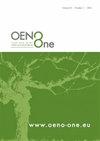Novel algorithms for high-resolution prediction of canopy evapotranspiration in grapevine
IF 2.2
3区 农林科学
Q3 FOOD SCIENCE & TECHNOLOGY
引用次数: 1
Abstract
Developing low-cost technology for custom water delivery to individual or small groups of plants is a critical next step to advance precision irrigation. Current systems for estimating evapotranspiration (ET), or plant water use, work on the scale of a full vineyard (e.g., 3–5 acres) or the scale of a single vine, but at a cost that prohibits monitoring past a small number of representative vines. To develop and evaluate low-cost ET sensors for individual grapevines, we used three head-pruned Zinfandel vines in pots and placed them on load cells to collect continuous weights indicative of actual ET. We mounted research-grade sensors for humidity, temperature, and wind speed on each vine and saved data at 2-minute intervals during three growing seasons. We developed three models based on first principles (Convective Mass Transfer or Mass Balance approaches) or simple correlations to predict actual single-plant ET from these data. We present here the results of a multi-year trial at the UC-Davis RMI vineyard to illustrate the performance of each of the models for ET estimation. Relative model performance was assessed by comparing model predictions to ground truth data provided by measurements from load cells–including assessments of estimated instantaneous ET rate, estimated cumulative water use over a one-hour window surrounding solar noon, and estimated cumulative water use over a full 24-hour period. The three algorithms developed consistently performed well, with single vine ET rate predictions showing a strong linear relationship with ground truth (range in r2 over three seasons CMT r2 = 0.61–0.86; MB r2 = 0.07–0.91; EM r2 = 0.57–0.92). The MB approach, which includes two measurements of relative humidity and temperature, was the most variable, likely due to the impact of sensor placement. In all seasons, we also examined the trend in the plant scaling factor found in each model, deemed As, which, based on model theory, is a function of vine size. Taken together, these results suggest that high-resolution irrigation (HRI) models are a promising new method for ET estimation at the single plant level.葡萄树冠层蒸散量高分辨率预测新算法
开发低成本技术,为单个或小群植物定制供水,是推进精准灌溉的关键下一步。目前用于估算蒸发蒸腾(ET)或植物水分利用的系统,是在整个葡萄园(例如,3-5英亩)或单个葡萄藤的规模上工作的,但其成本不利于监测少数具有代表性的葡萄藤。为了开发和评估单株葡萄的低成本ET传感器,我们将三棵剪了头的馨芳葡萄放在花盆里,并将它们放在称重传感器上,以连续收集实际ET的重量。我们在每棵葡萄上安装了研究级的湿度、温度和风速传感器,并在三个生长季节每隔2分钟保存一次数据。我们开发了三个基于第一性原理(对流传质或质量平衡方法)或简单相关性的模型,以从这些数据预测实际的单厂ET。我们在这里展示了在加州大学戴维斯分校RMI葡萄园进行的多年试验的结果,以说明每个模型用于ET估计的性能。通过将模型预测与称重传感器测量提供的地面真实数据进行比较,评估了相对模型的性能,包括评估估计的瞬时ET率,估计的太阳正午周围一小时窗口内的累积用水量,以及估计的整个24小时期间的累积用水量。开发的三种算法表现一致,单藤ET率预测与地面真实值表现出很强的线性关系(三个季节的r2范围CMT r2 = 0.61-0.86;MB r2 = 0.07-0.91;EM r2 = 0.57-0.92)。MB方法,包括相对湿度和温度的两个测量,是最可变的,可能是由于传感器放置的影响。在所有季节,我们还检查了在每个模型中发现的植物比例因子的趋势,认为As,根据模型理论,它是藤蔓大小的函数。综上所述,这些结果表明,高分辨率灌溉(HRI)模型是在单株水平估算ET的一种有前景的新方法。
本文章由计算机程序翻译,如有差异,请以英文原文为准。
求助全文
约1分钟内获得全文
求助全文
来源期刊

OENO One
Agricultural and Biological Sciences-Food Science
CiteScore
4.40
自引率
13.80%
发文量
85
审稿时长
13 weeks
期刊介绍:
OENO One is a peer-reviewed journal that publishes original research, reviews, mini-reviews, short communications, perspectives and spotlights in the areas of viticulture, grapevine physiology, genomics and genetics, oenology, winemaking technology and processes, wine chemistry and quality, analytical chemistry, microbiology, sensory and consumer sciences, safety and health. OENO One belongs to the International Viticulture and Enology Society - IVES, an academic association dedicated to viticulture and enology.
 求助内容:
求助内容: 应助结果提醒方式:
应助结果提醒方式:


